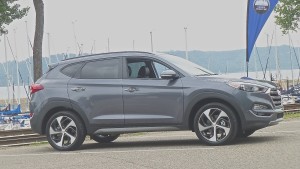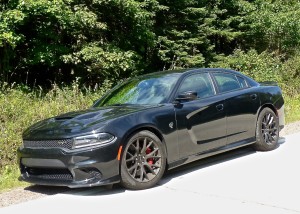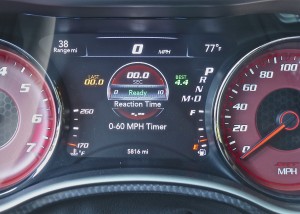All-new 2016 Tucson Lifts CUV Stature
Filed under: Equinox, Autos
By John Gilbert
It was just five years ago that Hyundai put South Korean automotives on the global map by redesigning the midsize Sonata from a dull sedan into a stunning, flashy and technology-filled showpiece. Almost immediately, the technology spread to all the other Hyundai cars, as well to everything from Kia, its newly adopted partner. Hyundai’s SUVs benefitted too, although they seemed almost as after-thoughts.
Since then, the SUV market has skyrocketed, so Hyundai improved the Santa Fe to new levels of function and luxury, with two versions, including a slightly shorter Sport, that keeps its distance larger than the compact crossover Tucson. For the 2016 model year, and for the first time since Hyundai technology peaked, the Tucson gets its moment in the sun, and the timing couldn’t be better for the new CUV (Crossover Utility Vehicle).
The compact crossover segment that numbered about five vehicles a decade ago now numbers over 40. Everybody has one, or two, and some are outstanding. All of them are in hot pursuit of the affordable segment stars — the Honda CR-V, Toyota RAV4, Ford Escape, Nissan Rogue, and, more recently, the Mazda CX-5.
As of right now, one out of every three vehicles sold is an SUV, and the compact CUVs are flat taking over. It makes sense, because if you want something that can haul a little more, offers more storage room, and has the anxiety-free stability of all-wheel drive, then the most compact SUVs also offer more maneuverability and fuel economy.
The Tucson used to be a more modest and less expensive alternative to the top sellers, but the new 2016 Tucson goes immediately to the head of the class. It is completely redesigned, and now resembles a compact version of the stylish Santa Fe. Its high-tech stuff either stands out immediately, or resides more subtly beneath the skin, where it makes the vehicle stiffer, handle better, is safer and more versatile.
The last Tucson redesign came in 2010, and it was a solid step upward, but nothing like this one. Before approaching the many details, consider that the new Tucson starts with front-wheel drive available as a $1,400 option in all versions. The SE starts at a base price of $22,700; the SE Pop starts at $23,450; the Eco at $24,150; the Sport at $26,150; the Limited at $29,900; and the Limited Ultimate at $32,650. It’s hard to find a capable compact car for $25,000 these days. Read more
Charger Hellcat Offers 707-HP Family Sedan
Filed under: Weekly test drives, Autos
By John Gilbert
Maybe you’ve heard about the techniques of professional drag-racing, where drivers line up at the amber starting lights, then time it as perfectly as they can to launch without “red-lighting” an instant before the green light shows.
If you can find a place to try that in the ol’ family truckster, it’s fun. And if you happen to be driving a 2015 Dodge Charger SRT Hellcat, it’s more than just fun. Sure, it costs a little more than the garden variety Charger — close to $65,000 — but it comes fitted with a 707-horsepower supercharged 6.2-liter Hemi, and various accompanying toys.
One of them is that on the instrument panel, along with showing you your speed and RPMs and fuel gauge, you can switch to several screens. One of them, under “performance,” gives you a cluster of numbers between the speedometer and tach. Set it for 0-60, or 0-100, or a quarter-mile, and then hit the button when you’re ready to go. It counts down, and when it gets to your starting time, you accelerate as hard as you dare. The readout not only gives you a timed clocking of how you did, but it also shows your starting-line reaction time, for how close you cut the launch to the quickest possible time.
I found a deserted stretch of rural highway, and set the device for 0-60. Then I hammered it. After a couple runs, I showed a best time of 4.4 seconds. Dodge says the car will do the quarter mile in less than 14 seconds, and I have no reason to question that. If you know of a deserted stretch of rural highway, you realize immediately that you could spend a few bucks refueling before you get over the adrenaline kick of spending an afternoon playing with that Charger Hellcat.
The best thing about it, along with the looks and the amazing performance, is that when you simply start the engine and crack the throttle, people stop and stare, while you’re just happy your windows didn’t shatter. Read more






 John Gilbert is a lifetime Minnesotan and career journalist, specializing in cars and sports during and since spending 30 years at the Minneapolis Tribune, now the Star Tribune. More recently, he has continued translating the high-tech world of autos and sharing his passionate insights as a freelance writer/photographer/broadcaster. A member of the prestigious North American Car and Truck of the Year jury since 1993. John can be heard Monday-Friday from 9-11am on 610 KDAL(www.kdal610.com) on the "John Gilbert Show," and writes a column in the Duluth Reader.
John Gilbert is a lifetime Minnesotan and career journalist, specializing in cars and sports during and since spending 30 years at the Minneapolis Tribune, now the Star Tribune. More recently, he has continued translating the high-tech world of autos and sharing his passionate insights as a freelance writer/photographer/broadcaster. A member of the prestigious North American Car and Truck of the Year jury since 1993. John can be heard Monday-Friday from 9-11am on 610 KDAL(www.kdal610.com) on the "John Gilbert Show," and writes a column in the Duluth Reader.